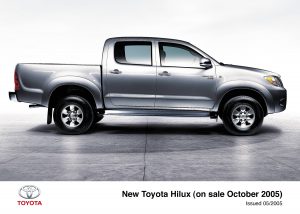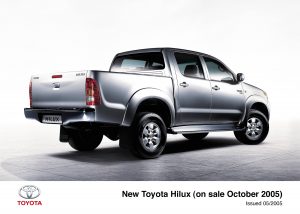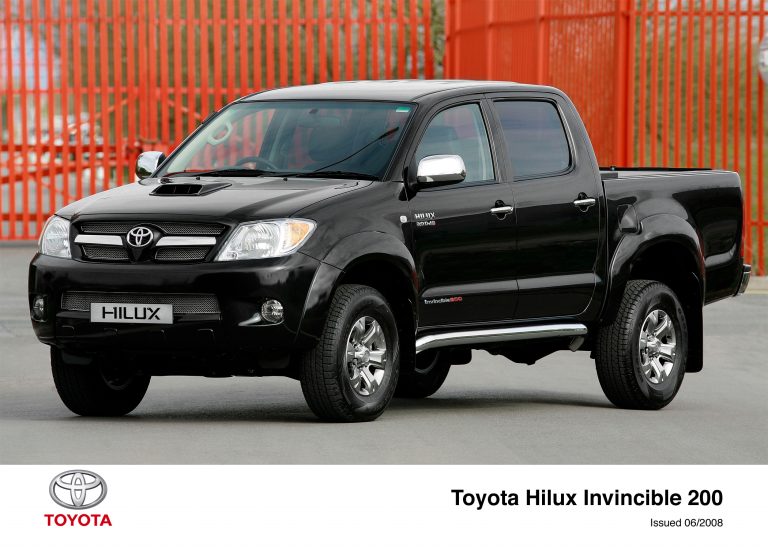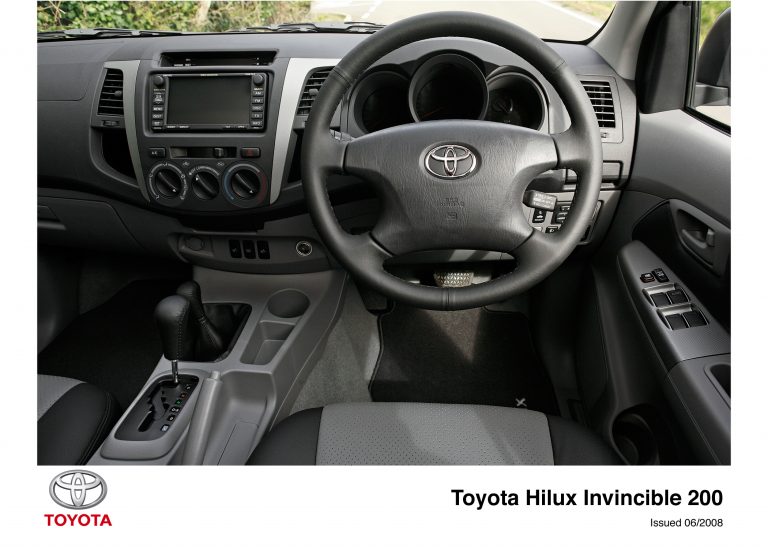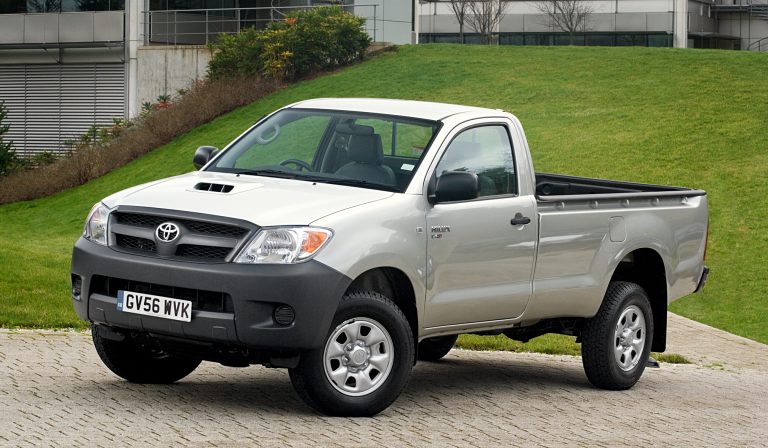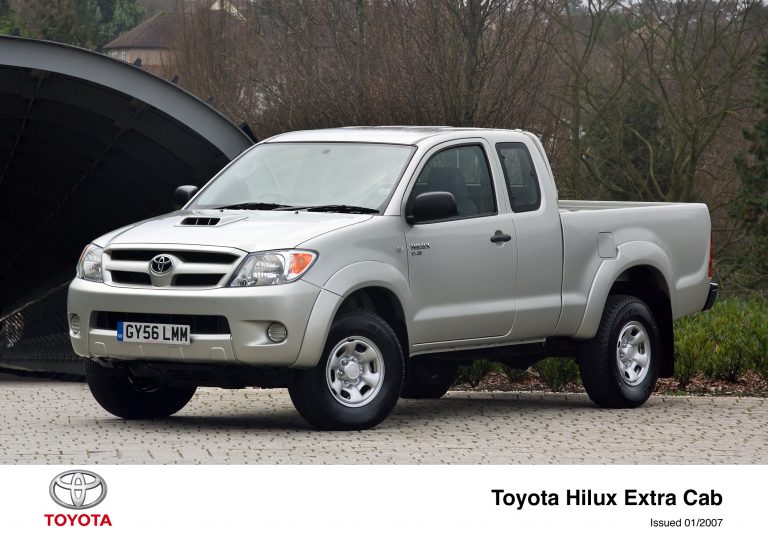European Premiere For The New Toyota Hilux
Latest generation of the “indestructible” pickup unveiled at Barcelona
KEY POINTS
- Sixth generation of Toyota’s second most successful global model
- Unveiled this week at the Barcelona motor show
- European and UK sales to start in October this year
- Hilux showcases Toyota’s legendary quality, durability and reliability
- Reinforced ladder frame chassis
- All-new suspension for improved ride
- Longer and wider than before, for extra load carrying and passenger space
- Improved interior space and comfort
- European models to be built to substantially higher technical and equipment specifications than versions currently offered by independent UK importers
- More than 12 million units produced since 1967
SHORT STORY
The Toyota Hilux was famously the vehicle the Top Gear television team couldn’t destroy. Now an all-new model has broken cover, combining the legendary toughness of its predecessor with more room in the cabin, extra load-carrying capacity and better quality all-round.
The sixth generation of what is Toyota’s second best-selling global model (after Corolla) made its European debut this week at the Barcelona motor show. Sales in Europe and the UK will start in October.
The first generation Hilux was launched in Japan in 1967 and since then it has enjoyed continuous development and built a worldwide reputation for never-say-die toughness, reliability and power.
In creating the new Hilux, Toyota set an extremely ambitious goal: to develop a vehicle for business, leisure and adventure with all the strengths of its predecessors; that could deal with conditions from the world’s harshest environments.
In Europe new Hilux will contribute to Toyota’s strategy of increasing customer choice and building its market share, marketed at an affordable price alongside the SUV range of RAV4, Land Cruiser and Land Cruiser Amazon.
The new model has more interior space, improved driving characteristics, greater comfort and improved quality. It will be available in Single Cab and Double Cab body styles to cover a broad range of customer needs for both business and pleasure.
ROCK SOLID CONSTRUCTION
The new Hilux is built on an all-new ladder frame chassis, giving it strong off-road capability. The chassis is unique to the model and uses a larger box section than the current Hilux with torsional stiffness increased by 45 per cent. This gives greater body control and reduces noise intrusion in the cabin. An impact brace between the front and first cross-members effectively absorbs impact forces and protects other chassis components from damage in the event of a collision.
The front suspension features independent double wishbones with coil springs which provide maximum travel and bump absorption and maintain good straight line stability and feel. Traditional leaf springs are used at the rear to maintain an excellent load carrying capacity and avoid intrusion into the flat bed.
Major body panels are made of high-tensile sheet steel which increases strength, durability and crash protection. An anti-chipping coating has been added to exposed areas such as the door sills and underbody to protect against corrosion.
Aerodynamic styling has helped improve fuel consumption and reduce noise levels with elements such as an engine undercover and wind deflectors.
At the time of launch the new Hilux will be offered with Toyota’s 102bhp 2.5-litre D-4D diesel engine with second-generation common rail injection and swirl control system. The engine’s power and maximum 260Nm of torque (200Nm on two-wheel drive models) make it a flexible performer for both work and leisure driving.
The five-speed manual transmission has been made smoother and easier to use, with a better gear change feel. The powertrain line up will be expanded in the future starting with an intercooled version of the 2.5 D-4D next year.
The transfer gearbox enables four-wheel drive and a rear axle limited slip differential is fitted as standard to give improved traction in slippery conditions. Selected grades will also offer a differential lock.
MORE SPACE, MORE PRESENCE
The new Hilux has great visual impact, not least as it is considerably larger than the model it replaces. Its great road presence reflects its heritage as a working vehicle in some of the toughest environments around the world.
Double Cab and Single Cab with both two and four-wheel drive transmissions will be available. Both models offer more space, particularly in the cabin where class-leading quality and comfort have been achieved.
The new Hilux is 5,130mm long, making Single and Double Cab versions 340mm longer than the current model. It is also considerably wider (+60mm Single Cab, +45mm Double Cab), but is the same height as before. Most of the additional length is in the wheelbase, extended to 3,085mm. This allows for greater interior space and a more comfortable ride for passengers.
The load deck is also bigger. The vertical sides allow for width to increase by 50mm (55mm in Single Cab). It’s longer, too: up by 155mm in Single Cab and 165mm in Double Cab. Total load lengths are now 2,315mm for the Single Cab and 1,520mm for the Double Cab.
In line with the actual and perceived quality characteristics for which Toyota passenger cars are renowned, the new Hilux benefits from tighter panel fit and clearances. The instrument panel fit now compares to that on the Toyota Avensis, while door clearance on all frames has been reduced to between 4.5 and 5mm.
Quality materials are used for the full interior trim, doorsills are fitted with scuff plates and the interior has an impact-absorbing headlining.
The Double Cab will comfortably accommodate five people with improved seat design longer cushions, extra slide and recline adjustment and adjustable headrests in the rear. The rear seat can also be folded up to increase load space. Storage space is improved with extra cupholders, larger door bins, centre cubby holes and larger centre console box.
A WORLDWIDE PROJECT
The new Hilux is one of three vehicles being developed on a global basis through Toyota’s IMV (Innovative International Multi-purpose Vehicle) project. IMV products are designed to sell in more than 140 countries and meet modern customer demands.
The IMV line-up comprises three Hilux pick-ups, a minivan and an SUV. There are no plans to bring the minivan and SUV to Europe. The project is a ground-breaking approach to draw on the resources and potential of countries outside Japan as global production and supply bases for vehicles and components.
The IMV vehicle production base includes South Africa, Thailand, Indonesia and Argentina. Major components, such as diesel engines, come from Thailand, petrol engines from Indonesia and manual transmissions from India.
Initial worldwide production targets were 505,000 vehicles a year, spread across the four manufacturing countries. Sales of the new Hilux started earlier this year in Asia, Oceania and South America and have exceeded expectations.
For the European market, Toyota will take production of Single Cab and Double Cab models from South Africa and Extra Cab models from Thailand.
INDEPENDENT IMPORT ISSUES
As the new Toyota Hilux has been launched in other markets around the world ahead of its European and UK launch in October, some customers have been able to secure examples built in Thailand through independent importers.
There are important differences in the engineering and specification of these models, compared to those which will be built to European standards.
Where safety is concerned, vehicles built for the Thai market may not have ABS as standard and a driver’s airbag is only available on the top model grade; passenger airbags are not available. In addition, seatbelts do not have pretensioners, there are no child locks on the rear doors and there is no rear centre headrest.
The Thailand specification vehicle is set up as non commercial which can compromise the ride when carrying heavier loads. The anti-corrosion protection is also not of the same standard as European-specification versions.
ENDS


